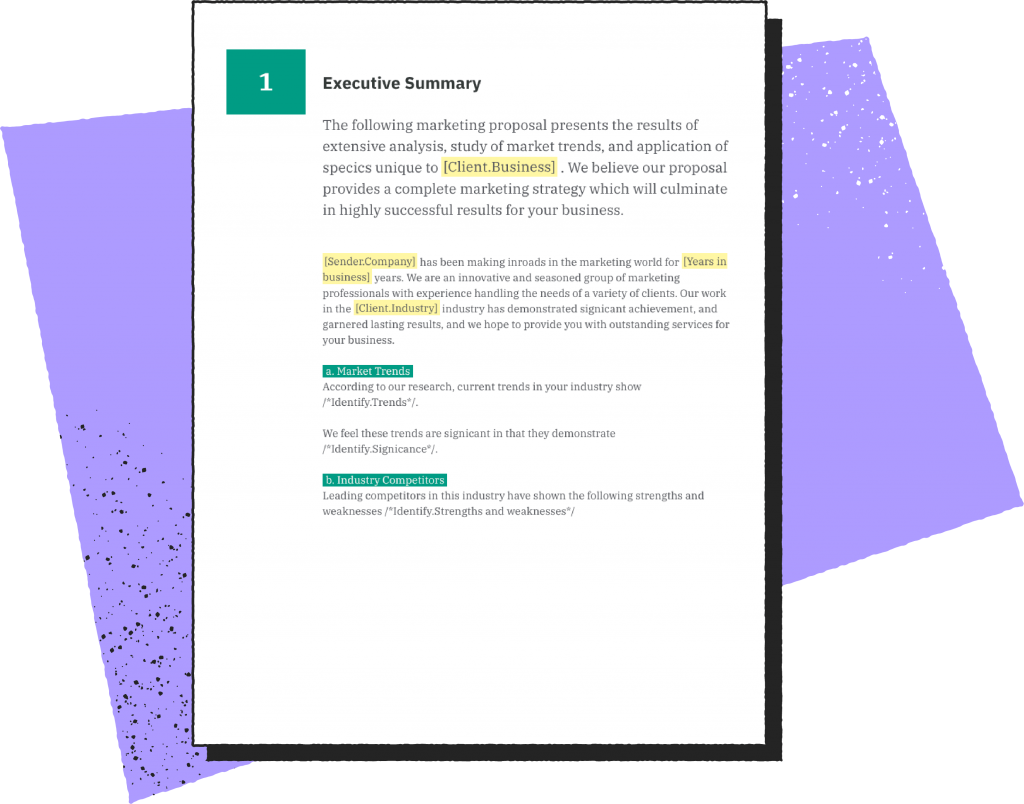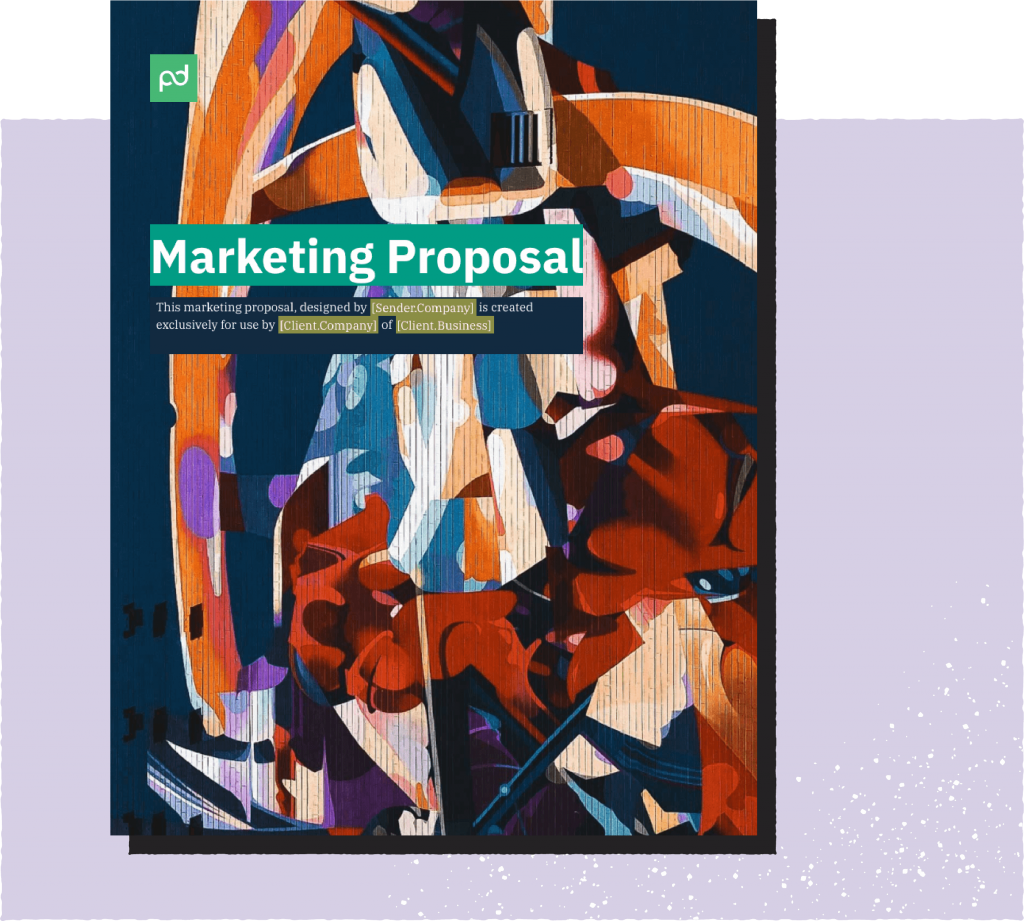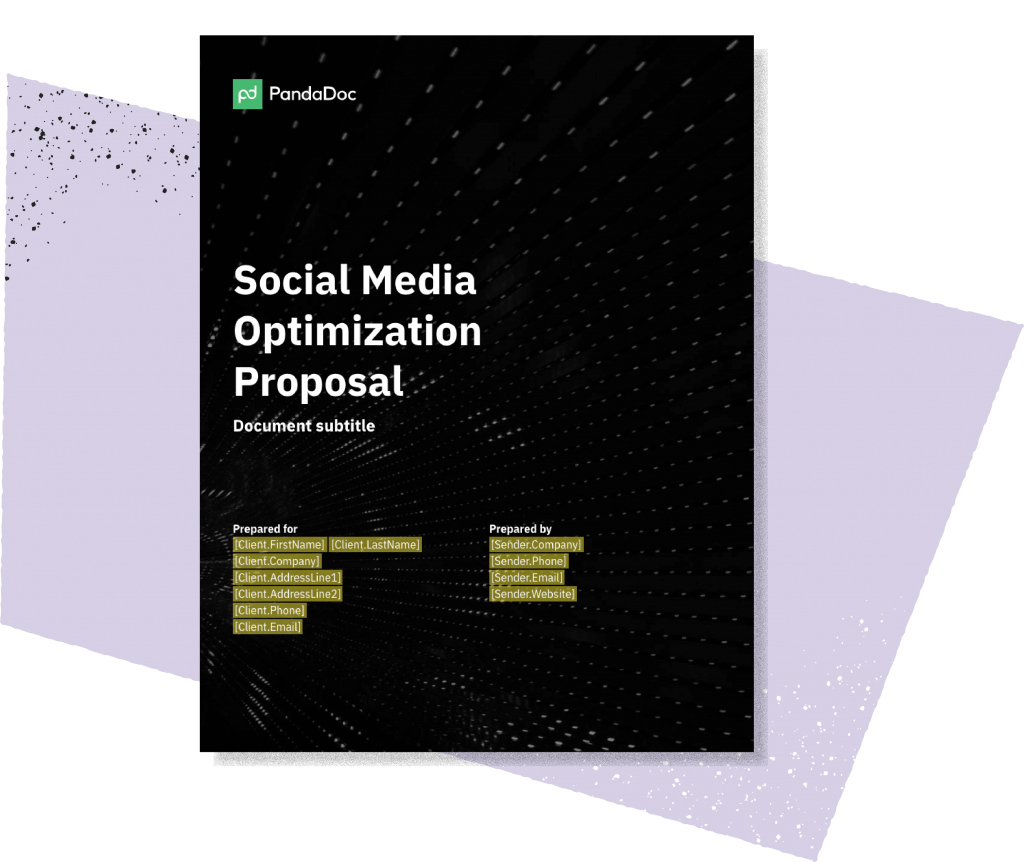
Your marketing proposal is your opening statement to your new clients. It lays out the details of your strategy, implementation, costs, and means of acceptance.
A marketing proposal should make it clear what it is that you offer, how you intend to do it, and what makes you different from and better than your competitors.
To write your perfect marketing proposal, you need to develop a plan and then follow it, as with anything in business.
How to write a persuasive marketing proposal
-
Research your client’s needs
-
Develop an action plan
-
Frame the proposal
-
Write the marketing proposal
-
Winning the bid
-
Put altogether in handy marketing proposal templates
-
Some last do’s and don’ts about marketing proposals
-
Covering it up
Step 1: Research your client’s needs
A marketing proposal must be targeted to your intended clients. This means doing research on the client’s firm or business, identifying the client’s problems and marketing needs, and understanding what their competitors are already doing.
Researching your client may take some time but will result in a more comprehensive proposal.
Look for what marketing specialists call “pain points.” A pain point is a problem within the client’s marketing strategy that needs to be repaired, but the client either doesn’t know how or doesn’t realize it’s a problem.

A pain point could be a poorly targeted ad campaign or an improperly monitored Facebook page. The goal of early research is to find these issues, then surprise the client by describing the problem and the solution before they ask.
You can obtain this information from a variety of sources:
1. Discussion with the client. Sitting down with the client to discuss the project and feel out the pain points will yield a great deal of additional information. How much the client is willing to spend and the kind of time frame they want will come up in your discussions.
2. Social media. Analyzing your clients’ Facebook, Yelp, and Google reviews can tell you where their potential weak and strong areas are.
3. Regional data. By learning about marketing preferences in your client’s area, you can tell them what types of services you will provide to meet their needs in your proposal.

Step 2: Develop an action plan
Once you have collated all your research, you will develop a plan for the client. This plan will form the basis of your proposal.
The action plan should:
1. Identify each issue and your strategy for dealing with that issue. Each identified issue should have a problem statement and a proposed solution based on your discussions with the client.
For instance, if the client’s main problem is that their social media advertising lacks targeted keywords, that would be the problem statement.
2. Estimate the time needed for each proposed solution. This will provide the numbers for the timeline that goes into the proposal.
This is where you will determine how long your staff needs to complete their parts of the solution, how long an off-site contractor will take to return a project, and so on. By estimating the total time needed, you will have numbers to plug into your client’s timeline.
3. List any measurements or metrics that will be used to assess the success of your solution. These factors will go into the proposal at the end of the timeline so the client will know when the project is complete.
When this is done, you can sit down to write the proposal.
Step 3: Frame the proposal
Once your research is done and your action plan is developed, you must set up your basic framework.
This is where a template is a useful tool.
Whatever the type of proposal you are writing, it should always contain the following information:
1. Your company information. This is data about who you are, why you are uniquely qualified for this job, and why the client should pick you over any other agency.
Your company information can be kept in a separate file because it will be mostly the same for each proposal. Your team should have standard bios and headshots ready to go for each project.
2. Knowledge of the issues. This will summarize the data you obtained in your research and discussion sessions.
3. Methodology and pricing. This is what you are going to do and how much it will cost. Methodology and pricing usually have their own section, near the end of your proposal.
4. Initial action plan. The action plan in the proposal may be your final offer or not, as discussed below.
Step 4: Write the marketing proposal
With all of these elements together, you can write the proposal.
Your marketing proposal will have several distinct parts:
- Cover page
- Executive summary (introduction)
- Action plan (methodology)
- Timeline
- Research and brainstorming
- Pricing
- Conclusion and next steps
1. Cover page
It might seem superfluous or unnecessary, but a good cover page is the first thing your potential client will see.
Even in our digital age, proposals are printed out or hard copies may be requested, so a good cover page or title page is a must.
The cover page should have your company’s name and contact information, the client’s name and contact information, and the preparer.
PandaDoc’s proposal templates have cover pages to suit every need, with customizable options to fit your business design.
2. Executive summary

Also called the introduction, the executive summary is a brief overview of who your company is, what your proposal offers, and why this proposal should be accepted by the client.
Although the executive summary is the first thing your client will read (and possibly the only thing), you should write it last, after the rest of the proposal has been completed.
The executive summary should be a balance between a general overview of the goals of the project and the research you’ve based your project on, without being too broad and nonspecific.
The executive summary should provide the reader with a good idea of what the project is going to accomplish without getting bogged down in technical details.
If your proposal is delivered in electronic format, the executive summary can include links to your company website or other documentation.
If the proposal is meant to be printed or will be both electronic and printed, your internal links should also include footnotes or a bibliography with links for the readers to access later.
3. Action plan
The action plan is the meat of your proposal. In this section, which may include multiple subsections, you will lay out the plan that you devised from your analysis and discussions with the client during the research phase.
A possible plan might look like this:
Part one: State the issue you will be focusing on. Using the information from your research, describe the problem specifically and how your proposal will address it.
For example: “We found that your Facebook advertising is missing about one-third of your target market,” or “We intend to re-optimize your SEO (search engine optimization) so that your advertising falls back in line with your intended audience.”
Part two: Give a timeline for both managing the issue and assessing your solution.
For example: “We have allotted four weeks for the optimization and will assess the effectiveness in three months, six months, and nine months to allow for the time it takes for the change to show up in Facebook’s algorithms.”
Part three: Explain how any issues that might arise will be handled and what follow-up the client can expect.
For example: “If it appears in three months that the desired effect is not beginning to appear, our SEO experts will reassess your advertising to see if the ads need to be reworded.”
Part four: Describe how your pricing is managed.
For example: “The optimization is done on a contract basis per project, and the monitoring of your advertising is done in-house on an hourly basis.”
This would be repeated for each step of the proposed project. Small projects or proposals would naturally have shorter action plans, whereas large projects or clients might have multiple plans with many subsections.
One caveat: The proposal should not be so complicated that it is impossible to read. If the project is so large that it requires multiple action plans, it would be best to write a separate proposal for each section.
4. Timeline
Each part of the action plan will have a short timeline of its own, but the entire project should have a timeline from start to finish, and this timeline will have its own section in your proposal.
Deadlines are an important part of any contract. If any of the deadlines in your proposal are not feasible for you or the client, it is best to know about it during the proposal process, and not after the final contract has been signed.
Surprisingly, many proposals fail to include a timeline, either because the writer didn’t think it was important or believed that it would be included in the contract. A timeline in your proposal shows that your team has already thought about how and when the important parts of the project are due and what both you and the client can expect.
The timeline gives both you and the client a visual representation of the project and what benchmarks to expect going forward.
5. Research and brainstorming
In this section, you should provide a detailed explanation of the research and analysis that went into developing your action plan.
Include any market research and trends you relied upon and information about discussions and brainstorming sessions you engaged in with your client and focus groups.
For smaller projects, this section might be incorporated into the action plan. Larger projects will need more information gathering, and the client will appreciate seeing the work you put into it.
This is also a place to provide support for your plans by showing the current technology in the field.
6. Pricing
Pricing needs to be detailed and specific. Don’t be afraid to tell your client exactly how much something will cost. It’s better to be upfront about cost than to surprise the client later with unexpected expenses.
Precise cost estimates also prevent scaring the client with ballpark estimates that might be too large. By creating a comprehensive action plan ahead of time, you can clearly describe to your client what is going to be done and how much each step will cost. This avoids sticker shock later on.
Responsive pricing tables let you define each step as a separate line item with its own price.
For large or complex projects, for instance, where your team will have to handle coding as well as SEO and placement, each step would have its own line and price.
This lets the client decide if a step is one they want and whether the price is reasonable to them. Responsive pricing is a key part of negotiating a proposal.
7. Conclusion
All proposals should have a wrap-up page that finishes the proposal. In an electronic format, there should be a link to redirect the viewer to the contract and the executive summary.
The conclusion should be brief, no more than one or two lines, to let the client know they have reached the end of your proposal.
If the proposal is intended to be an actual offer, there are two more sections you will need to include.
Step 5: Winning the bid

If your proposal is meant to be an actual offer for a contract, your proposal needs to have terms and conditions and an agreement to the contract section.
For your general template, you can leave out the terms and conditions and just write this section for each new client as you obtain them.
One caveat: If you’re intending that your proposal be a contract, have your in-house counsel or an attorney review your package before you send it out. This is not intended to be legal advice!
Terms and conditions
The terms and conditions page must include all the requirements for the client to accept the proposal as written.
To be a legal contract, the terms and conditions must include the start date, the end date, the agreed-upon price, and how payments will be accepted.
The terms and conditions must also make it clear whether the contract will allow amendments before signing without altering the amount due.
Agreement and call to action
The agreement language needs to be precise and make it clear that the client is accepting the proposal on the date of signing, and that work will commence with the signing of the document.
Never assume that the client has accepted the proposal until you get the signed copy back!
On the flip side, make sure the client understands that you won’t begin working until they sign.
Many clients assume that the proposal is the contract and that work has begun, but have been surprised to learn months later that you are still waiting to hear from them. Following up with them within a day or two is essential.
Put altogether in handy marketing proposal templates
PandaDoc has identified the best marketing templates for nearly every business. These easy-to-use templates have helped companies large and small put together proposals in less time than they thought possible!
For example, Arinex event management cut their proposal time by 25% using PandaDoc templates and increased their closing success rate by 32%.
Bonusly, a B2B software company, experienced a whopping 70% reduction in paperwork thanks to PandaDoc’s flexible template design.
Marketing proposal template

Marketing proposal template is suitable for small business proposals. It includes a straightforward layout that lets you show your prospective clients that you can meet their goals in a timely and cost-effective manner.
A winning marketing proposal has all the elements in a logical order, and a good template won’t let you forget any of them.
Video proposal template

Embedded video is now nearly a requirement for websites and online advertising. Videographers need an electronic proposal that showcases their skills and demonstrates their ability to address the client’s issues as effectively as any written proposal.
Product and service videos can show off in a few seconds what it takes words pages to describe. This template gives video specialists the chance to present a proposal in a visual format where their skills can shine.
Social media marketing proposal template

Social media marketing proposal template includes everything from Facebook to Twitter and more.
Being able to pitch a marketing plan to clients both large and small requires a template that highlights your team and your research into social media optimization for the client’s market.
PandaDoc has general templates as well as Facebook- and Twitter-specific templates to focus your abilities in those areas. Templates are recommended by all marketing strategy gurus, and these are some of the best available.
Some last do’s and don’ts about marketing proposals
You’ve written your proposal and sent it off to the potential client. While you wait for it to be reviewed and sent back, there are likely other proposals to write. Here are some tips to consider for your marketing proposals:
- Do have someone edit your proposal before you send it out. Besides running a spell check and grammar check, have a fresh set of eyes go over it for typos that the spell check might not catch. Nothing looks as bad as mistaking “their” for “there” and other common typos.
- Do include graphics and statistics where relevant. Clients love to see clear charts and eye-catching images. A picture is worth a thousand words, even in your marketing proposal.
- Do remember that you’re selling yourself. It’s easy to forget that your product is you and your company. It’s OK to upsell your brand, as long as it isn’t obtrusive.
- Don’t spend too much time on yourself instead of your client. How you’re going to help the client deal with their needs and problems is most important.
- Don’t fill your proposal with fluff. If you have nothing to say, say nothing. Short and concise is always best for proposals.
- Don’t reinvent the wheel. PandaDoc has many templates available that can be customized to suit your needs. You have enough to do without creating a whole new template for your company.
- Lastly, don’t do all this hard work if you don’t have to. Marketing proposals are used when you are pitching your services or products to a customer that has not told you much about the project. You do all the work and present it to the customer. There is a different sort of proposal that PandaDoc can help you with.
Covering it up
The proposal is your opening into your client’s business, and it should look as good as anything you present to the customer.
These tips and links should give you the edge you need to produce a clear, clean marketing proposal for all of your clients’ needs.
Originally published April 27, 2018, updated June 2, 2021
Looking For Document Management System?
Call Pursho @ 0731-6725516
Check PURSHO WRYTES Automatic Content Generator
https://wrytes.purshology.com/home
Telegram Group One Must Follow :
For Startups: https://t.me/daily_business_reads



